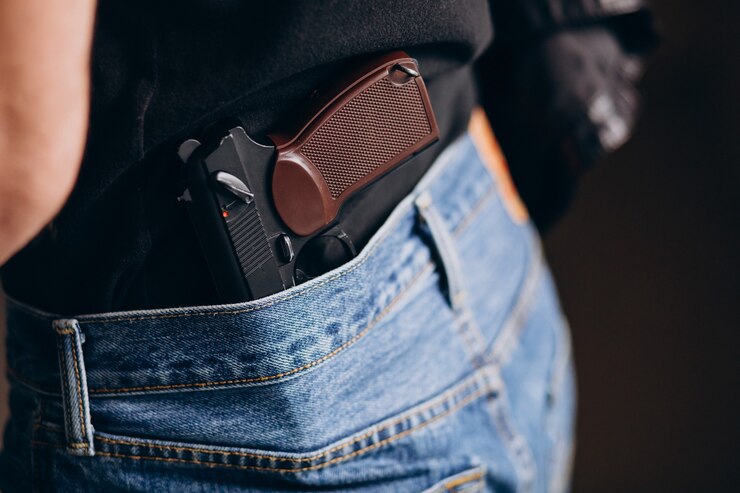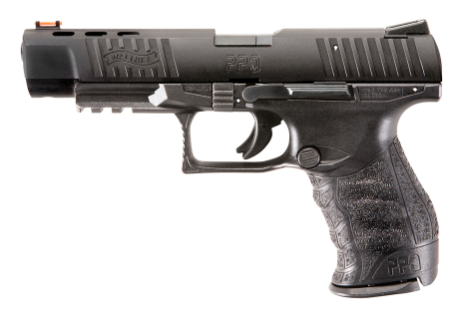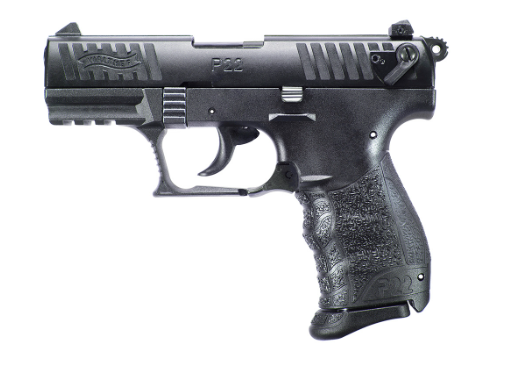Written by Mark Buff , GunZee founder and CEO.
Inside-the-waistband (IWB) carry is one of the most widely used carry positions for CCW. IWB holsters offer convenient, accessible concealed carry. Optimize comfort, security, and draw speed by following some of our simple tips for how to wear an IWB holster.
Quick links:
Learn how to position your concealed carry holster on your waistline properly, choose the ideal cant, and make key adjustments so that you can get the most out of your IWB holster.
Gunzee’s memory foam holster pad is a no-brainer. Enjoy comfortable IWB carry and say goodbye to gouging, chafing, and constant readjusting.
Position correctly on the waistline
Set your IWB holster between the 11 to 1 o'clock position, either centered or slightly towards your strong-hand side. This allows a smooth, unimpeded draw as the grip will ride high on your abdomen. It also prevents the barrel from digging into or putting pressure on your pelvis while seated.
Adjust the exact height depending on your torso length, body shape, and grip size. Find the right vertical position to eliminate discomfort by avoiding pressure points. While a faster draw is desired, prioritize all-day carry comfort in your positioning.
Once you’ve identified your most comfortable position, tweak tension screws and molding to perfect weapon retention. You want the shortest, most efficient path to firmly grasp your firearm. Fine-tuning balances a secure hold with efficient accessibility after the ideal ride height is determined.
Choose an ideal cant and angle
One advantage of inside-the-waistband holsters is the ability to adjust the angle or cant. This lets you tailor the position both for quick access when drawing and concealing the grip with your clothing. The proper cant adjustment improves comfort and performance.
A slight rearward rake is often recommended as a starting point. Angling the grip 15-20 degrees away from the stomach can work well by keeping the grip tight to the body to hide under clothing, while still allowing an efficient draw stroke. Comfort and optimal positioning depend on a variety of factors such as body type, preferred carry position, and whether the priority is access or deeper concealment.
Testing different setups is key. Adjust the belt clips or loops from completely vertical to forward or rearward cants to see what carries best on your body while supporting your preferred draw motion. Finding the best angle may require evaluating different holster designs as well. An optimized cant for an IWB holster can significantly boost everyday carry performance and comfort.
Make adjustments for security
One of the challenges of inside-the-waistband holsters is to prevent shifting and ensure full coverage during body movement. You should start with a good covering garment such as an untucked shirt or jacket that falls between the grip and your beltline. This allows you to grasp the firearm grip cleanly without impedance while helping keep the IWB holster stable.
Practice standard motions (bending, sitting, and simulated draws) to evaluate coverage. Ensure no parts of the trigger or muzzle become exposed, adjusting ride height or cant if needed. The retention screws on many holster clips allow for tuning the grip tension for your gun model and belt rigidity. Apply enough calibrated tension for a secure hold during active use without making draw access overly difficult.
A properly adjusted IWB holster securely retains your weapon on your waistband, with suitable covering garments allowing efficient, unimpeded access to the grip when required. Perform regular checks and adjustments to account for factors like clothing changes or expected activity levels. A well-fitted IWB holster stays firmly and discreetly in place on your waistline.
How to choose the right IWB holster?
With so many holster options available, it may be hard for you to choose the right one for your needs. Here are some factors you should consider when choosing the right IWB holster:
- Consider the holster material and overall build construction when choosing an IWB option. This includes choices such as all-leather, injection-molded KYDEX, or hybrid holster designs combining both materials. Also evaluate features including adjustability, sweat guards, weight, rigidity, and durability. Testing the degree of custom molding to your firearm model is advised as well.
- Evaluate the weapon retention method used by the IWB holster. Different security escort requirements call for varying levels of restraint methods, ranging from basic handcuff holds (Level I) to more restrictive techniques using additional restraints like leg irons (Level III). Match the retention method closely to your personal carry needs, typical body movements, and with consideration for your carry environment (e.g. crowded and close-quarter environments).
- Carefully assess the area kept protected on your firearm's grip to muzzle. More coverage equals greater safety, but can also impede rapid access and draw speed when needed urgently. Find the ideal balance point for your personal safety and comfort zone.
- Prioritize comfort factors in an IWB holster model, specifically its contouring to minimize pressure points and abrasion on typical carry locations. This is especially important e for EDC comfort, and to minimize holster wear and tear.. Consider breathability in material choices here as well.
Choose the holster model that addresses all your key concealed carry requirements and comfort preferences. The right IWB holster will balance weapon security, ease of access when drawing your firearm, long-term comfort and wearability, and adaptability to different clothing choices.
How to wear an AIWB holster?
Appendix carry is one of the most popular carry positions. This position requires careful setup for safety and effective draw. While sitting, AIWB offers direct access to your weapon but takes practice to perfect secure positioning.
Follow these tips to wear your AIWB holster properly:
- Position carefully. Set your AIWB holster between the 12 to 1 o’clock belt positions for right-handers (11 to 12 o’clock for southpaws), adjusting the height to avoid pressure points from grip or slide. Consider a 15-degree muzzle angle away from the femoral arteries. Make sure your cover garment(s) provide adequate concealment.
- Add ride height. Use a holster with customizable ride height and angle, or choose one made for the appendix carry location. Raise the grip enough above the belt line to enable an efficient draw stroke while covering the trigger guard.
- Mind the cant. Angle your AIWB holster's grip 5-15 degrees outward from the abdomen depending on comfort and accessibility needs. Test drawing with different cants.
- Choose rigidity. Select an AIWB holster with good retention and little flex to prevent collapse or shifting during body movement or draw attempts. Durable KYDEX or hybrid materials often work well.
How to wear an IWB holster with a claw?
A claw attachment is a popular accessory addition for IWB holsters used for concealed carry. Properly positioned, an IWB claw helps further push the grip of your firearm into your body for effective concealment underneath garments. This lets an IWB holster with a claw hide your weapon exceptionally well.
Position the claw properly
Most IWB claw attachments affix behind the holster to any attachment point or belt clip. Make sure the accessory claw is secured firmly before use.
Set the attached claw so that curved hooks turn inward, with the angled shelf "grabbing" at your pants or belt to create leverage inward. Position the claw hooks between the 1 to 2 o’clock area at about the same height as your firearm's slide.
Angle the claw steep enough to generate sufficient leverage. Between 15-20 degrees inward is often an effective starting angle. The claw needs enough angle to properly grip the fabric and drive the grip firmly inward when tensioned against your belt or waistline.
Tuning angle and height
You may need to adjust both the claw angle and vertical position on your IWB holster to tune performance. Watch how the grip rides when holstered, and check concealment with different styles of covering garments.
If the grip still prints or protrudes too much, consider increasing the claw angle for more leverage, or move the claw higher to apply leverage nearer your slide. Ensure no sharp claw pressure points develop during these adjustments.
With experimentation, you can fine-tune the claw position to get full weapon concealment using this effective accessory addition to an IWB holster. Tension and angle combine to allow the claw to effectively "pull" the entire holster deeper under clothing layers.
IWB carry positions
With these holsters you have the flexibility to experiment with different IWB carry positions to find the best fit for your needs. Here are some of the most common and popular carry methods:
- Strong-side hip carry. The strong-side hip carry position from 4-5 o'clock or 5-6 o'clock is one of the most widely used IWB carry methods. This allows fast access on your dominant-hand side with good concealment.
- Kidney carry. Placing an IWB holster over the kidney area along the back of your waistline (around the 6-7 o'clock position) allows comfortable long-term wear while keeping the grip hidden under untucked shirts.
- Appendix carry. Appendix carry at the 12-1 o'clock front positions offers direct access to your firearm when seated. This needs careful setup to ensure security and optimal draw angle.
- Weak-side carry. For left-handed shooters, wearing an IWB holster between the 7-8 o'clock positions mirrors the advantages of strong-side carry for right-handed shooters.
- Cross-draw carry. Positioning an IWB cross-draw holster at 8 o'clock or 9 o'clock can work well for accessibility from a seated vehicle position.
Experimenting with carry spots lets you optimize comfort, concealment, and easy access when you need to draw. Adjust ride height and cant to fine-tune any IWB carry position.
About GunZee
GunZee makes concealed carry comfortable. No more uncomfortable KYDEX holsters digging into your waist! That's why we created our memory foam holster pad to enhance the comfort of everyday carry for all body types.
Our holster padding conforms perfectly to your body's natural contours for supreme comfort. Once you try it, you'll wonder how you ever lived without it.
Caring for your trusted everyday carry piece is also super important. Our easy-to-use handgun cleaning kits help keep your pistol in flawless working order. We also offer an all-in-one universal gun cleaning kit that covers your cleaning needs for pistols, rifles, and shotguns—everything the responsible gun owner needs to maintain their firearm collection.
IWB holster FAQ
What is the safest IWB carry position?
The safest IWB carry position for most concealed carriers is the appendix position, typically centered around the 12-1 o'clock belt positions. This frontal position allows easy access and quick checks to make sure the pistol is properly concealed at all times.
What is the most comfortable position for IWB?
The most comfortable IWB carry position depends on personal preferences. Many find the 3 o'clock position comfortable, while others prefer the 4 o'clock position. Experiment with different positions to find the most comfortable one for your body type, preferences, and daily activities.
What is the purpose of a wedge on an IWB holster?
The purpose of a wedge on an IWB holster is to push the grip of the gun towards the body, reducing printing and increasing comfort. It also helps in distributing the weight of the gun more evenly, making it more comfortable to carry, especially for extended periods.
Can you sit down with an appendix holster?
You can sit down with an appendix holster. Some people find it easier to access their firearm from the seated position with an AIWB holster. However, it's essential to ensure that the holster is positioned in a way that is comfortable and does not dig into the body while sitting
What is the average draw time from concealment?
While the average draw time depends greatly on specific gear, training, dress, adrenaline, and other variables, research indicates most average draw times from concealment fall between 1.5 to 3 seconds for competent civilian shooters. This time can be higher when including follow-up shot speed and accuracy against a threat beyond initial access.
What is the 3 o’clock carry position?
The 3 o'clock carry position refers to carrying the firearm on the strong side of the hip bone, which is directly at the 3 o'clock position for a right-handed shooter. This position allows for a natural draw and is comfortable for many individuals.
Where is the best IWB position for fat guys?
The best IWB position for fat guys is towards the back hip around 5-6 o'clock. This position avoids the common 11-1 o'clock positions near the front abdomen that can be problematic for concealment on bigger waistlines and cause excessive printing through cover garments.
Is shoulder carry better than IWB?
Most people find a properly adjusted IWB holster at strong side hip or appendix positions conceals better and allows faster access compared to shoulder carry. Some people, on the other hand, still prefer the comfort of horizontal shoulder holsters depending on body type, clothing, and personal preferences around draw efficiency.
Can you tuck in your shirt with an IWB holster?
You can tuck in your shirt with an IWB holster. There are specific holsters designed to allow you to tuck in your shirt while carrying concealed. These holsters have clips that attach over the waistband, allowing the shirt to be tucked in while keeping the firearm concealed
What holster type is the best for concealment?
For deep concealment, hybrid or full KYDEX IWB holsters offer minimal printing under clothing. They owe it to their stiff/rigid structure and full sweat guards that break up the defined grip outline profile, compared to materials such as thin leather that flex and collapse too easily.
Can you use an IWB holster for open carry?
While it's possible to use an IWB holster for open carry, it's not the most common choice. Open-carry holsters are typically designed differently from those used for concealed carry, and they may not provide the same level of retention and security as holsters specifically designed for open carry.
Are inside the waistband holsters safe?
With proper tension adjustment, full trigger coverage, weapon security features, and user training, IWB carry is generally safe compared to poor-quality holsters and duty use. However, certain IWB positions like appendix have elevated injury risks if incorrect draw techniques and other protocols aren't followed.
Can you concealed carry without a belt?
Belly band holsters and undershirts with integrated retention can be concealed carried securely without a belt for short durations. The lack of strong-side stabilization risks grip shifting and poor retention over long spans of unbelted use. You will need to check and readjust the position of your pistol quite often, so these beltless methods serve only as emergency backups, not primary carry methods.
What type of clothing is the best for effective concealed carry?
For effective IWB concealed carry without printing, loose-fitting tops work better than tight clothing. Solutions include overlays such as overshirts, loose-fitting pants, jackets, button-downs, and untucked polos that disguise the definition of the holstered weapon against the body.
About the Author
Mark Buff is the founder and CEO of GunZee. He is an ardent firearms enthusiast and has been carrying concealed for more than 15 years. He created GunZee to solve his own problem: that of uncomfortable KYDEX holsters. His patented GunZee memory foam holster pad makes inside-the-waistband carry super comfortable.
Further reading
What is the best semi-auto for concealed carry?
What is the best CCW gun for left-handers?
What is the best IWB holster for women?
What is the best 9mm for IWB carry?
What is the best undershirt for IWB carry?
What is the best compact pistol for IWB carry?



